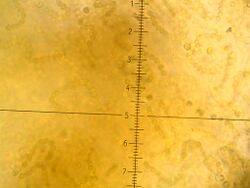Biology:Fat choy
| Fat choy | |
|---|---|

| |
| Nostoc flagelliforme under a microscope | |
| Scientific classification | |
| Domain: | Bacteria |
| Phylum: | Cyanobacteria |
| Class: | Cyanophyceae |
| Order: | Nostocales |
| Family: | Nostocaceae |
| Genus: | Nostoc |
| Species: | N. flagelliforme
|
| Binomial name | |
| Nostoc flagelliforme | |
| Synonyms[1] | |
| |
| Fat choy |
|---|
Fat choy (simplified Chinese: 发菜; traditional Chinese: 髮菜; pinyin: fàcài; Jyutping: faat³ coi³; Nostoc flagelliforme) is a terrestrial cyanobacterium (a type of photosynthetic bacteria) that is used as a vegetable in Chinese cuisine. When dried, the product has the appearance of black hair. For that reason, its name in Chinese means "hair vegetable". When soaked, fat choy has a soft texture which is like very fine vermicelli.
Production
Fat choy grows on the ground in the Gobi Desert and the Qinghai Plateau. Over-harvesting on the Mongolian steppes has furthered erosion and desertification in those areas. The Chinese government has limited its harvesting, which has caused its price to increase.[2]
Commercially available fat choy has been found to be adulterated with strands of a non-cellular starchy material, with other additives and dyes.[2][3] Real fat choy is dark green in color, while the counterfeit fat choy appears black.[2]
Use
China
Its name in Cantonese sound the same as a Cantonese phrase meaning "struck it rich" (though the second syllable, coi, has a different tone) -- this is found, for example, in the Cantonese saying, "Gung1 hei2 faat3 coi4" (恭喜發財, meaning "wishing you prosperity"), often proclaimed during Chinese New Year. Therefore, it is a popular ingredient for the Chinese New Year, like in the reunion dinner. It is enjoyed as an alternative to cellophane noodles.[citation needed] It is mostly used in Cantonese cuisine and Buddhist cuisine. It is sometimes used as a hot pot ingredient.
Due to its high price, fat choy is considered a luxury food, and only used in limited occasions. It is not eaten as a staple.[4]
Viet nam
Fat choy is also used in Vietnamese cuisine. It is called tóc tiên or tóc thiêng (literally "angel's hair") in Vietnamese.
Health effects
N. flagelliforme has no nutritional value,[dubious ] and also contains beta-N-methylamino-L-alanine (BMAA), a toxic amino acid that could affect the normal functions of nerve cells and is linked to degenerative diseases such as ALS, Alzheimer's, Parkinson's, and dementia.[5] Not all real fat choy samples contains BMAA according to an 2009 study, with the maximum concentration being 658.5 ng/g. Imitation fat choy does not contain BMAA.[4]
Across a 28-day duration, laboratory rats fed N. flagelliforme and the control group did not exhibit significant differences in any toxicological parameters.[6]
The algae and its extracts reduce the inflammatory action of white blood cells, specifically macrophages and splenocytes, in vitro.[7]
References
- ↑ Cite error: Invalid
<ref>tag; no text was provided for refs namedCalvo-Pérez - ↑ 2.0 2.1 2.2 "The standard.com.hk". http://www.thestandard.com.hk/news_detail.asp?pp_cat=11&art_id=37176&sid=11956724&con_type=1.
- ↑ "Waynesword". http://waynesword.palomar.edu/cyano1.htm.
- ↑ 4.0 4.1 Roney, BR; Renhui, L; Banack, SA; Murch, S; Honegger, R; Cox, PA (2009). "Consumption of fa cai Nostoc soup: a potential for BMAA exposure from Nostoc cyanobacteria in China?". Amyotrophic Lateral Sclerosis 10 (Suppl 2): 44–9. doi:10.3109/17482960903273031. PMID 19929731.
- ↑ The standard.com.hk. Mimi Lau, January 30, 2007, Ban sought on Lunar delicacy
- ↑ Takenaka 1998.
- ↑ Ku, Lee (2013). "Edible blue-green algae reduce the production of pro-inflammatory cytokines by inhibiting NF-κB pathway in macrophages and splenocytes". Biochimica et Biophysica Acta (BBA) - General Subjects 1830 (4): 2981–2988. doi:10.1016/j.bbagen.2013.01.018. PMID 23357040.
- But, Paul Pui-Hay; Cheng, Ling; Chan, Pui Kwan; Lau, David Tai-Wai; But, Joyce Wing-Hin (2002). "Nostoc flagelliforme and faked items retailed in Hong Kong" (in en). Journal of Applied Phycology 14 (2): 143–145. doi:10.1023/a:1019518329032. ISSN 0921-8971.
- Takenaka, H.; Yamaguchi, Y.; Sakaki, S.; Watarai, K.; Tanaka, N.; Hori, M.; Seki, H.; Tsuchida, M. et al. (1 December 1998). "Safety evaluation of Nostoc flagelliforme (nostocales, Cyanophyceae) as a potential food" (in en). Food and Chemical Toxicology (United Kingdom) 36 (12): 1073–1077. doi:10.1016/S0278-6915(98)00089-1. ISSN 0278-6915. PMID 9862649. http://agris.fao.org/agris-search/search.do?recordID=GB1999006166. Retrieved 22 October 2018.
External links
- "Cyanobacteria Photos". http://waynesword.palomar.edu/cyano1.htm.
- "food for thought". sg.bcmagazine.net. 1 February 2004. http://sg.bcmagazine.net/cgi-bin/output.cgi?issue=027&&id=14.
Wikidata ☰ Q3273745 entry
 |

